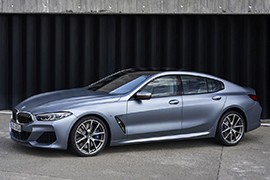BMW 8 Series Gran Coupe Models/Series Timeline, Specifications & Photos
First production year: 2019
Engines: Diesel, Gasoline
After it replaced the 6 Series with the 8 Series in coupe shapes, the German automaker continued its offensive on the premium sports sedans market and introduced the Gran Coupe version of the 8 Series in June 2019, and sales started in September of the same year.
Based on the same CLAR architecture as the 7 Series (G11) and the 5 Series (G30) launched in 2015 and 2016, respectively. BMW competed with its four-door coupe against vehicles such as the Mercedes-Benz CLS, AMG GT 4-Door coupe, and the Panamera from Porsche. Unfortunately for the München-based automaker, its car came right before the world pandemic started, and, as a result, its sales plummeted. Still, it was an appreciated vehicle, and the wide choice of engines and options made it a desirable four-door coupe, suitable for those who wanted a luxurious vehicle but with a sporty character and demanding view on the road.
The car’s front fascia was shared with its two-door sibling. It featured a pair of swept-back standard LED headlights that sported hexagonal-shaped daytime running lights. In addition, the automaker offered the option for Laser headlamps. A distinct bumper with a large center air intake in the lower part, flanked by massive side scoops, cooled the engine and the front rotors. From its profile, the extracting vents behind the front wheel wells were not just decorations, just like on its coupe sibling. Unlike that version of the 8 Series, the Gran Coupe featured more upright A-pillars and an arched roof that started to descend above the rear seats. At the back, the short deck was sloped and, depending on the version and options featured a spoiler. For the rear fascia, BMW installed a set of wide taillights extended from the quarter panels to the trunk’s lid.
Inside, the automaker installed a four-seat layout with two individual seats at the front and a bench seat in the back profiled for two adult-sized passengers. Thanks to the straighter and taller greenhouse, the front seat occupants enjoyed better headroom than in the two-door coupe. The driver fronted a fully digital instrument cluster and, atop the center stack, in a free-floating position, the touchscreen for the infotainment system. The front occupants could access the menus from the iDrive unit either via touch functions or the specific rotary dial controller housed on the center stack. In the back, there was just enough headroom for those seated there, and they were divided by a tall transmission tunnel and a fold-down armrest.
Under the hood, BMW installed the same engine lineup as in the coupe, fueled by gasoline or diesel. The automaker installed turbocharged inline-six and V8 units that sent power in all corners via an eight-speed automatic transmission.
